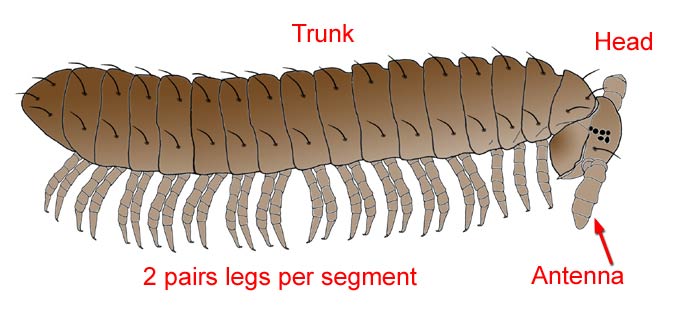| |
Common names: millipedes, thousand-leggers, pill bugs
Probability of
encounter: high
Quarantine importance:
no known importance, although a few species are minor pests of crops and some
produce poisonous or caustic defensive secretions. Some of the larger
millipedes are used in the pet trade.
Similarity to mites:
none, although many species have mites associated with them.
Polyxenida
are mite-size, but otherwise unlikely to be confused with mites.
Normal adult length: 2 mm - 28 cm
Body tagmata: head, trunk
Eyes: absent or 2-80 ocelli
Antennae: usually relatively short
Mouthparts: ectognathous mandibles with large 'cheeks', maxillae (gnathochilarium)
Legs: 3-numerous pairs
Respiration: 4 spiracles per diplosegment, opening on sternite near
coxae
Gonopore: venter of 3rd trunk segment (behind 2nd pair of legs)
Distinguishing features: diplosegments each with two pairs of legs,
second maxillae absent, 1st trunk segment (collum) legless
Many millipedes look as if they have thousands of legs, which gives this group
its name and allows easy identification - at least of the larger specimens.
All have distinct heads with antennae and elongate bodies with many segments
having two pairs of legs (diplosegments). Body segments are added during development,
so recently hatched individuals could be confused with springtails, insects,
or mite larvae (6-legged) or with later stages of mites (8-legged).
First instar millipedes
may have only 6 legs, and could be confused with insects or springtails (Collembola),
but millipedes lack a distinct thorax. The minute species in the genus
Polyxenus
look very much like hairy beetle larvae and except for very young millipedes
in other orders, are the only common diplopods in the microarthropod size category.
Diversity:
perhaps 15 orders, >8000 spp.
References
Tree of Life -
http://tolweb.org/tree?group=Diplopoda&contgroup=Arthropoda
Hoffman, RL. 1990. Diplopoda.
pp. 835-860, in DL Dindal (ed) Soil Biology Guide. John Wiley & Sons: Brisbane.
Hopkin, SP and Read HJ. 1992. The Biology of Millipedes. Oxford University
Press: Oxford.
